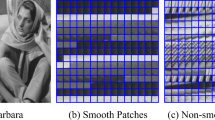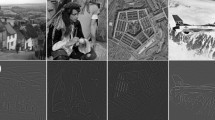Abstract
Focused on the issue that the object structure discontinuity and poor texture detail occurred in image inpainting method, the image inpainting algorithm based on self-adaptive group structure has proposed in this paper. The conception of self-adaptive group structure is different from traditional image patching operation and fixed group structure, which refers to the fact that a patch on the structure has fewer similar patches than the one within the textured region. A self-adaptive dictionary as well as the sparse representation model was established in the domain of self-adaptive group. Finally, the target cost function was solved by Split Bregman Iterational operation. The experimental results on target removing with Criminisi’s algorithm, GSR’s algorithm and SALSA’s algorithm in image pixels losting of image inpainting had shown that the proposed algorithm has better performance than other algorithms.






Similar content being viewed by others
References
Guillemot, C., Le Meur, O.: Image inpainting: overview and recent advances. IEEE Signal Process. Mag. 31, 127–144 (2014)
Chan, T., Shen, J.: Local inpainting models and tv inpainting. SIAM J. Appl. Math. 62, 1019–1043 (2001)
Chan, T.F., Shen, J.: Non-texture inpainting by curvature-driven diffusions. J. Vis. Commun. Image Represent. 12, 436–449 (2001)
Ram, I., Elad, M., Cohen, I.: Image processing using smooth ordering of its patches. IEEE Trans. Image Process. 22, 2764–2774 (2013)
Wong, A., Orchard, J.: A nonlocal-means approach to exemplar-based inpainting. Proceedings of the 15th IEEE International Conference on Image Processing. IEEE, 2008, pp. 2600–2603 (2008)
Criminisi, A., Perez, P., Toyama, K.: Region filling and object removal by exemplar-based image inpainting. IEEE Trans. Image Process. 13, 1200–1212 (2004)
Shen, B., Hu, W., Zhang, Y., et al.: Image inpainting via sparse representation. Proceedings of the IEEE International Conference on Acoustics, Speech and Signal Processing. IEEE, 2009, pp. 697–700 (2009)
Li, Z., He, H., Yin, Z., et al.: A color-gradient patch sparsity based image inpainting algorithm with structure coherence and neighborhood consistency. Signal Process. 99, 116–128 (2014)
Xu, Z., Sun, J.: Image inpainting by patch propagation using patch sparsity. IEEE Trans. Image Process. 19, 1153–1165 (2010)
Mairal, J., Bach, F., Ponce, J.m et al.: Non-local sparse models for image restoration. Proceedings of the IEEE 12th International Conference on Computer Vision. IEEE, 2009, pp. 2272–2279 (2009)
Zhang, J., Zhao, D., Gao, W.: Group-based sparse representation for image restoration. IEEE Trans. Image Process. 23, 3336–3351 (2014)
Xu, J., Zhang, L., Zuo, W., et al.: Patch group based non-local self-similarity prior learning for image de-noising. Proceedings of the IEEE International Conference on Computer Vision, 2015, pp. 244–252 (2015)
Wang, Z., Bovik, A.C., Sheikh, H.R., et al.: Image quality assessment: from error visibility to structural similarity. IEEE Trans. Image Process. 13, 600–612 (2004)
Goldstein, T., Osher, S.: The split Bregman method for L1-regularized problems. SIAM J. Imaging Sci. 2, 323–343 (2009)
Afonso, M.V., Bioucas-Dias, J.M., Figueiredo, M.A.T.: Fast image recovery using variable splitting and con-strained optimization. IEEE Trans. Image Process. 19, 2345–2356 (2010)
Liu, H.P., Sun, F.C., Fang, B., Zhang, X.Y.: Robotic room-level localization using multiple sets of sonar measurements. IEEE Trans. Instrum. Meas. 66(1), 2–13 (2017)
Liu, H.P., Guo, D., Sun, F.C.: Object recognition using tactile measurements: Kernel sparse coding methods. IEEE Trans. Instrum. Meas. 65(3), 656–665 (2016)
Liu, H.P., Liu, Y.P., Sun, F.C.: Robust exemplar extraction using structured sparse coding. IEEE Trans. Neural Netw. Learn. Syst. 26(8), 1816–1821 (2015)
Acknowledgements
This work is supported by the National Natural Science Foundation of China (No. 61402053, No. 51408069), the Science and Technology Service Platform of Hunan Province (No. 2012TP1001).
Author information
Authors and Affiliations
Corresponding author
Rights and permissions
About this article
Cite this article
Mo, J., Zhou, Y. The research of image inpainting algorithm using self-adaptive group structure and sparse representation. Cluster Comput 22 (Suppl 3), 7593–7601 (2019). https://doi.org/10.1007/s10586-018-2323-8
Received:
Revised:
Accepted:
Published:
Issue Date:
DOI: https://doi.org/10.1007/s10586-018-2323-8




